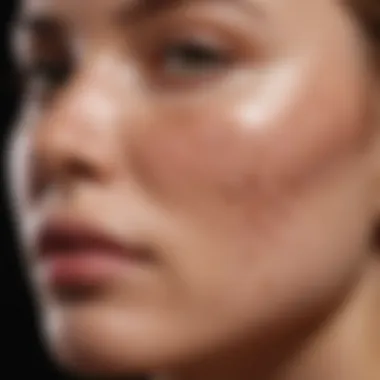Exploring the Efficacy of Anti-Age Spot Creams


Intro
As we navigate through the complexities of skincare, age spots emerge as a common concern for many individuals, particularly women. These spots, also known as hyperpigmentation, tend to originate from prolonged sun exposure, hormonal changes and sometimes genetics. Understanding how anti-age spot creams work is essential. These products promise to address such pigmentation issues, fostering healthier skin. This article will thoroughly explore the formulations, effectiveness, and science behind these creams.
The inquiries about the composition and impact of anti-age spot creams are critical. Consumers deserve to know what active ingredients are at play and how they function. Moreover, it is valuable to discuss appropriate application methods and the influence of lifestyle choices on skin health. This discussion will help individuals make informed decisions about their skincare routines. By examining current research and expert opinions, this article seeks to empower women to embrace their aging skin with confidence, armed with knowledge and effective solutions.
Trending Topics
The beauty industry is constantly evolving, bringing forth new insights and practices. While exploring anti-age spot creams, it is important to understand the current trends that shape their formulations and applications. This section delves further.
Current Fashion Trends
One of the emerging trends in beauty is the focus on sustainability. Brands are increasingly opting for eco-friendly packaging and formulations with natural ingredients. This shift promotes not only skin health but also environmental well-being. Such choices resonate with consumers who prioritize sustainable practices.
Beauty Innovations
Another highlight in the beauty industry is the incorporation of technology in product development. Innovations such as skin analysis devices help consumers identify their skin type and specific needs. Consequently, brands can design targeted products that cater to individual challenges, enhancing overall efficacy.
Step-by-Step Guides
Understanding how to incorporate anti-age spot creams into a daily skincare regimen is important. This section offers guidance on integrating these products effectively.
Beauty Routines
- Cleansing: Start with a gentle cleanser tailored to your skin type. Choose formulations with minimal irritants.
- Toning: Apply a toner that prepares the skin for subsequent treatments. Look for one without alcohol to maintain hydration.
- Anti-age Spot Cream: Use a specific cream designed for hyperpigmentation. Apply a small amount, focusing on affected areas, and allow it to absorb fully.
- Moisturizing: Finish with a moisturizer that complements your skin’s hydration needs.
- Sunscreen: Never skip sunscreen during the day. Protecting the skin from UV radiation is critical in preventing further pigmentation.
Product Reviews
In this section, a closer examination of specific products creates a factual basis for selection.
In-Depth Analysis of Popular Items
Creams like Olay Luminous Tone Perfecting Cream and Kiehl's Clearly Corrective Dark Spot Solution have gained attention for their efficacy. These products often contain proven ingredients such as Vitamin C and niacinamide that target age spots effectively.
Comparative Reviews
When evaluating efficacy, consider factors such as ingredients, user reviews, and clinical studies. This analysis can help guide decisions. Couples of examples include:
- Olay Luminous: Known for affordability and visible results notable in users.
- Kiehl's: Generally recognized for high-quality formulations but at a higher price point.
"Understanding your skin's needs and choosing the right product is essential.
This structured approach to evaluating anti-age spot creams allows individuals to navigate this complex landscape, making informed decisions that suit their personal skincare needs.
Foreword to Anti-Age Spot Creams
Age spots, often called liver spots or solar lentigines, are common skin blemishes that can appear as we get older. Understanding how to effectively reduce their appearance is crucial for anyone aiming for a more youthful complexion. This section introduces the essential concepts surrounding anti-age spot creams, elucidating their importance and guiding the reader through their benefits.
The prevalence of age spots is connected to an increase in sun exposure and the natural aging process of the skin. Aging skin tends to lose its ability to regenerate, leading to hyperpigmentation. For many women, combating these visible signs of aging is a significant part of their skincare routines. Treatment options have evolved significantly, thus it becomes essential to discern the efficacy and specifics of various products available in the market.
Anti-age spot creams are formulated specifically to target melanin production and encourage even skin tone. These products can offer tremendous benefits, including lightening existing spots, preventing new ones from forming, and improving the overall texture and appearance of the skin.
To maximize their use, one must consider critical factors such as skin type, individual formulation, and synergy with other skincare products.
In this article, we will delve deeper into the composition, mechanism of action, and potential efficacy of these creams. Moreover, we will analyze the lifestyle factors that can influence their effectiveness.
"Understanding the various elements of anti-age spot creams enables women to make informed choices in their skincare routines."


By the end of this discourse, the reader will gain critical insights into navigating the market for anti-age spot treatments, thereby enhancing their approach to skincare and improving their overall skin health.
Key Ingredients in Anti-Age Spot Creams
The composition of anti-age spot creams is crucial for their efficacy. In this section, we will dissect the key ingredients commonly found in these formulations. Understanding these components helps in making informed choices about skincare. Many of these ingredients carry extensive research backing their effectiveness, which affirms their relevance in the fight against hyperpigmentation.
Hydroquinone
Hydroquinone is a well-studied agent known for its ability to lighten skin. It works by inhibiting the enzyme tyrosinase, which is essential in the production of melanin. With regular use, such creams can significantly reduce the visibility of dark spots. However, caution is necessary as hydroquinone can cause skin irritation in some users. It is advised to consult with a dermatologist before starting treatment, especially for prolonged use.
Retinoids
Retinoids, derivatives of vitamin A, play a vital role in skin cell turnover. They increase cell production and can help fade pigmentation over time. Retinoids also improve skin texture and reduce fine lines, yielding a more youthful appearance. Users should introduce retinoids gradually into their routine to minimize irritation, which can be common during initial use.
Vitamin
Vitamin C is another powerful ingredient found in many anti-age spot creams. This antioxidant helps to brighten the skin and reduce the appearance of age spots. It also protects against free radical damage, which accelerates skin aging. For optimal results, formulations containing stable forms of Vitamin C, such as ascorbic acid, should be considered. Regular incorporation into a skincare regimen can lead to more radiant skin over time.
Niacinamide
Niacinamide, also known as Vitamin B3, has gained popularity due to its multifaceted benefits. It helps reduce the appearance of dark spots, improves skin elasticity, and enhances the skin's barrier function. Its anti-inflammatory properties can be beneficial for more sensitive skin types. Due to its compatibility with other active ingredients, it is an excellent choice for those seeking a comprehensive approach to skincare.
Kojic Acid
Kojic acid is derived from fungi and is known for its skin-lightening properties. Similar to hydroquinone, it works by inhibiting melanin production. Many users appreciate its gentler profile compared to some harsher chemicals. However, it is essential to conduct a patch test to ensure there are no adverse reactions, as sensitive skin may react negatively to this ingredient.
Knowing the roles and implications of these key ingredients in anti-age spot creams assists consumers in making informed decisions. Selecting the right product can markedly influence the outcomes in treating age spots effectively.
How Anti-Age Spot Creams Work
Understanding how anti-age spot creams work is crucial for anyone exploring options to combat hyperpigmentation. These creams are formulated to address uneven skin tone, primarily focusing on age spots. This section outlines the mechanisms that drive their efficacy and highlights the importance of exfoliation in skin care.
Mechanisms of Action
The primary function of anti-age spot creams lies in their active ingredients, which target the overproduction of melanin, the pigment responsible for skin color. Different ingredients act through various mechanisms:
- Inhibition of Melanin Production: Ingredients such as hydroquinone work by directly inhibiting the enzyme tyrosinase, essential in melanin production. This slows down or stops the formation of new pigment in the skin.
- Accelerating Cell Turnover: Retinoids, on the other hand, promote faster skin cell turnover. They encourage the shedding of dead skin cells, which helps fade existing spots while improving overall skin texture.
- Antioxidant Effects: Vitamin C and niacinamide not only target hyperpigmentation but also provide antioxidant benefits. They protect skin from oxidative stress that can exacerbate discolorations.
By incorporating a blend of these active compounds, these creams combat age spots effectively, resulting in a more even skin tone.
"Understanding the mechanisms of action is essential for selecting the most suitable product for individual skin needs."
The Role of Exfoliation
Exfoliation plays a significant role in the effectiveness of anti-age spot creams. This process involves removing dead and dull skin cells from the surface, revealing fresher skin underneath. Here is why exfoliation is vital:
- Enhances Absorption: By exfoliating, the skin becomes more receptive to the active ingredients in the creams. This enhances their absorption and effectiveness, allowing for the maximum potential of the product to be achieved.
- Fades Existing Spots: Regular exfoliation helps fade age spots over time. It assists in breaking down the built-up pigment beneath the skin's surface.
- Prevents Clogged Pores: A good exfoliating routine prevents clogged pores, which can lead to more skin issues. This keeps the skin clear and improves its overall appearance.
In the context of anti-age spot treatment, a balanced approach combining these creams with regular exfoliation will optimize results and promote healthier skin overall.
Selecting the Right Anti-Age Spot Cream
Selecting the right anti-age spot cream is a critical step in addressing age-related skin concerns. Not all products are formulated the same way. Each cream can have unique ingredients and benefits that cater to various skin types and specific needs. It is important to make an informed choice based on personal skin conditions, desired results, and overall skincare routines. The effectiveness of these creams varies greatly. A well-selected product can lead to visible improvements in hyperpigmentation and overall skin tone.
In this section, we will explore factors that influence the selection of anti-age spot creams. These factors include skin type considerations and ingredient compatibility. Both play vital roles in determining the right product for individual skin conditions, ensuring that users can optimize their use effectively.
Skin Type Considerations


Understanding one's skin type is essential when choosing an anti-age spot cream. The skin can be categorized into several types: dry, oily, combination, sensitive, and normal. Each type has distinct characteristics and requires specific maintenance approaches.
- Dry Skin: Products that contain ample hydration components are crucial. Look for creams with ingredients like hyaluronic acid. These elements can help restore moisture while targeting spots.
- Oily Skin: Lightweight, non-comedogenic formulations are more suitable for oily skin. Anti-age spot creams containing salicylic acid or other exfoliants can be beneficial for this skin type, helping to reduce excess oil.
- Combination Skin: A balanced approach works best. Choose creams with gentle exfoliation and hydration properties to cater to both oily and dry areas of the skin.
- Sensitive Skin: Select creams with soothing ingredients. Niacinamide or chamomile extracts can reduce irritation while treating age spots.
By taking into account the skin type, one can better match the product to personal needs. It reduces the risk of adverse reactions and will likely lead to better outcomes.
Ingredient Compatibility
Ingredient compatibility is another key element when selecting an anti-age spot cream. Some ingredients can react negatively with each other or may cause irritation, depending on individual sensitivities.
Consider the following points when evaluating compatibility:
- Avoid Mixing: Certain ingredients like retinoids and vitamin C can irritate the skin when used together. It's advisable to apply them at different times.
- Layering: Some users benefit from layering products. Applying a serum before the cream can enhance absorption. However, ensure that the ingredients in both products are complementary.
- Patch Testing: Before fully integrating a new cream into a skincare routine, a patch test can help identify any possible reactions. Apply a small amount on a discreet area of skin and observe for 24 hours.
A well-informed approach to selecting anti-age spot creams can significantly enhance their effectiveness in combating hyperpigmentation.
Application Guidelines for Optimal Results
Application guidelines are crucial when it comes to using anti-age spot creams effectively. Understanding how to properly apply these products enhances their potential benefits and reduces the risk of adverse reactions. Clear guidelines ensure that each application is systematic and deliberate, leading to optimal outcomes in reducing hyperpigmentation.
Frequency of Use
The frequency of use is a pivotal factor in maximizing the efficacy of anti-age spot creams. Generally, most formulations recommend applying the cream once or twice daily. Applying the cream daily helps maintain a consistent level of active ingredients on the skin, promoting faster and more noticeable results. However, it is important to follow the specific recommendations on the product label, as different formulations may have different strengths.
- Start Slow: If you are new to these products, begin with once daily application. This approach allows your skin to acclimate to the active ingredients without overwhelming it.
- Monitor Response: Observe how your skin reacts. If irritation occurs, consider reducing the frequency or consulting with a dermatologist.
- Adjust Based on Tolerance: Once your skin shows no signs of irritation, gradually increase usage to twice daily, if recommended.
Consistency is key. Skipping days can lead to slower results and less efficient treatment.
Layering with Other Products
Layering anti-age spot creams with other skincare products can enhance their effectiveness, but care must be taken to avoid potential interactions. Knowing how to layer properly allows for the best absorption and efficacy of active ingredients.
- Order Matters: Apply the anti-age spot cream after cleansing and before moisturizing. This sequence ensures that the active ingredients penetrate the skin effectively.
- Compatible Products: Some ingredients work well together. For example, combining vitamin C with your spot cream can enhance the overall brightening effect. However, it is crucial to check compatibility. Ingredients like retinoids and alpha hydroxy acids can increase sensitivity and should be used cautiously together.
- Avoid Overloading: Too many products can lead to irritation. Stick to a few key items in your routine to allow each product to be effective without overwhelming your skin.
Proper application and layering techniques are fundamental when aiming for the best results with anti-age spot creams. They help in keeping the skin healthy and achieving a clearer complexion.
Adhering to these application guidelines can lead to better results and a smoother skincare routine.
Potential Side Effects and Considerations
Understanding the potential side effects and considerations when using anti-age spot creams is crucial for every consumer, especially for women who aspire to maintain healthy, youthful skin. Such products often contain potent ingredients intended to reduce hyperpigmentation, but their efficacy also brings forth the risk of irritation and allergic responses. Addressing these potential downsides ensures that users can make well-informed decisions regarding their skincare regimens and maintain optimal skin health.
Irritation and Sensitivity
Many individuals may experience irritation or increased skin sensitivity when using anti-age spot creams. This reaction can vary widely from person to person, depending on skin type, the strength of active ingredients, and product formulation. It is essential to recognize early signs of irritation, which may manifest as redness, itching, or a burning sensation.
To minimize these reactions, starting with a patch test is a wise approach. Apply a small amount of cream to a discreet area of skin to determine tolerance. If irritation occurs, discontinue use and consult a dermatologist for alternatives or solutions.
Furthermore, consider integrating products gradually into your routine rather than using them daily from the outset. Over time, skin may develop a higher tolerance to active ingredients like hydroquinone or retinoids. Always keep in mind that moisturizing regularly helps counteract the drying effects of some treatment creams.
Allergic Reactions
Allergic reactions to anti-age spot creams, while less common, represent a serious concern. Symptoms may include severe redness, swelling, and in some cases, blistering. Components such as fragrances, preservatives, or specific actives could provoke such reactions.
It is advisable to review the ingredient list carefully, especially for individuals with known allergies. In addition, formulations designed for sensitive skin may be better tolerated. If one experiences signs of an allergic reaction, seek immediate medical attention.
"Being aware of your skin's responses can guide you toward selecting the right anti-age spot cream for your needs."


Complementary Skin Care Practices
Complementary skin care practices play a pivotal role in enhancing the efficacy of anti-age spot creams. While using these products can effectively diminish the appearance of age spots, it is important to integrate additional practices that support overall skin health. By focusing on elements such as sun protection and proper hydration, individuals can maximize the benefits of their topical treatments. Ignoring these foundational aspects can undermine the desired outcomes of any skin care regimen.
Sun Protection
Sun protection is arguably one of the most critical components of any skin care routine. It is essential to understand that ultraviolet (UV) rays from the sun can exacerbate hyperpigmentation and contribute to the formation of new age spots. Regardless of the season, using a broad-spectrum sunscreen is important. An SPF of 30 or higher is generally recommended. This not only protects against UVB rays, which cause sunburn, but also UVA rays, which penetrate the skin more deeply and can lead to premature aging.
Incorporating proper sun protection involves:
- Daily Application: Sunscreen should be applied every morning, even on overcast days. Broad-spectrum sunscreen is best because it protects against both UVA and UVB rays.
- Reapplication: It is advisable to reapply sunscreen every two hours, especially if swimming or sweating.
- Physical Barriers: Wearing hats and clothing with UPF (Ultraviolet Protection Factor) can further shield the skin from harmful rays.
Implementing these practices not only aids in preventing new age spots but also enhances the effectiveness of anti-age spot creams being used.
Hydration and Moisturization
Proper hydration and moisturization are equally important in any skin care strategy. When the skin is well-hydrated, it can better absorb the active ingredients found in anti-age spot creams. Dehydrated skin may lead to a compromised skin barrier, reducing the effectiveness of topical treatments.
To maintain optimal skin hydration, consider the following:
- Good Skin Care Products: Look for moisturizers that contain hyaluronic acid or glycerin. These ingredients attract moisture to the skin, making it plump and healthy.
- Regular Drinking of Water: Staying hydrated from within is crucial. Aim to drink an adequate amount of water daily, as it supports all bodily functions, including skin health.
- Avoid Over-Cleansing: Using harsh cleansers too often can strip the skin of its natural oils. Gentle products that maintain the skin's moisture barrier should be prioritized.
By combining sun protection with effective hydration practices, users can create an environment where anti-age spot creams can perform their best. The health of one's skin is a holistic task that requires attention to various elements. In achieving this balance, visible improvements in skin hyperpigmentation are more likely.
Long-Term Efficacy and Research Insights
The exploration of long-term efficacy in anti-age spot creams is a crucial aspect of understanding how effective these products are over time. Many users want to know not only the immediate benefits but also whether continued use leads to sustained improvements in skin quality.
Several clinical trials focus on the effectiveness of specific ingredients in these creams and track changes in skin appearance over extended periods. Research shows that while many creams can produce visible results within weeks, the most significant improvements often occur after prolonged use. Thus, patients should be mindful that patience is key when integrating these products into their routine.
Long-term efficacy is impacted by several factors including skin type, environmental influences, and age. Those who commit to a regular skincare routine using products that contain effective ingredients like hydroquinone, retinoids, and vitamin C often report better outcomes. Moreover, studies indicate that users who combine anti-age spot creams with proper sun protection and moisturization tend to experience enhanced results.
Current Clinical Studies
Recent clinical studies are illuminating the effectiveness of specific active ingredients found in anti-age spot creams. For example, a study published in the Journal of Clinical Dermatology assessed the impact of a cream containing hydroquinone and tretinoin over a 24-week period. Results showed a significant reduction in pigmentation intensity among participants, with 72% reporting visible improvement.
Another notable study in Dermatologic Therapy explored the impact of vitamin C formulations. Participants using a stabilised vitamin C cream twice daily showed a marked improvement in skin brightness and a decrease in the appearance of age spots over twelve weeks.
These studies reinforce the importance of evidence-based formulations in skincare. Before choosing a cream, consumers should look for products supported by clinical research, as these are more likely to deliver the results they seek.
Expert Recommendations
Experts in dermatology recommend several best practices when using anti-age spot creams. Firstly, it is critical to recognize the importance of consistent application. Dermatologists suggest using the products twice a day for optimal results.
In addition, layering products should be approached carefully. For instance, applying a thin layer of anti-age spot cream before sunscreen is essential for maintaining skin hydration and providing the necessary sun protection, which is crucial for preventing further hyperpigmentation.
Moreover, experts stress the significance of tracking progress. Users should take photos over time to monitor the changes, which can help in adjusting the skincare regimen as needed. Adopting a holistic approach that includes a healthy diet and hydration can further enhance skin health.
"Patience and consistency are the true allies in skincare. Monitoring your progress is just as vital." - Dr. Emily Collins, Dermatologist.
Concluding Thoughts
The exploration of anti-age spot creams encompasses various critical aspects that ultimately inform the choices consumers make in their skincare journeys. The discussion surrounding this topic is significant as it empowers individuals with the knowledge necessary to combat hyperpigmentation and age-related skin concerns effectively. As age spots can appear as a result of prolonged sun exposure and aging, understanding the functionality and composition of these creams becomes essential for achieving a more youthful appearance.
Summary of Findings
Throughout this article, we have dissected the efficacy of anti-age spot creams by examining their key ingredients such as hydroquinone, retinoids, vitamin C, niacinamide, and kojic acid. These components work through different mechanisms, addressing skin concerns in targeted ways. The role of exfoliation has been emphasized as it enhances the absorption of these ingredients, leading to optimal results. Moreover, the research findings alongside expert recommendations provide a well-rounded view of how to utilize these products accurately.
In addition to product selection and application guidelines, the potential side effects and complementary practices, such as hydration and sun protection, underline the broader context of skincare health. Therefore, while these creams may serve as effective treatments, their efficacy is notably heightened when integrated into a comprehensive skincare regimen.
Looking Ahead in Skincare
As we anticipate ongoing advancements in dermatological research, the future of skincare appears promising. Continuous studies provide insights into innovative ingredient formulations and methods tailored to address various skin types. The growing trend toward personalized skincare solutions is becoming more evident, giving consumers options that are specifically suited to their skin’s needs. This shift holds potential for improved product safety, reduced irritations, and overall enhanced efficacy.
Furthermore, the integration of lifestyle factors in skincare cannot be overstated. Choices regarding diet, hydration, and sun exposure significantly influence skin health. Future discussions in this domain will likely emphasize holistic approaches that marry advanced formulations with healthy living practices.



